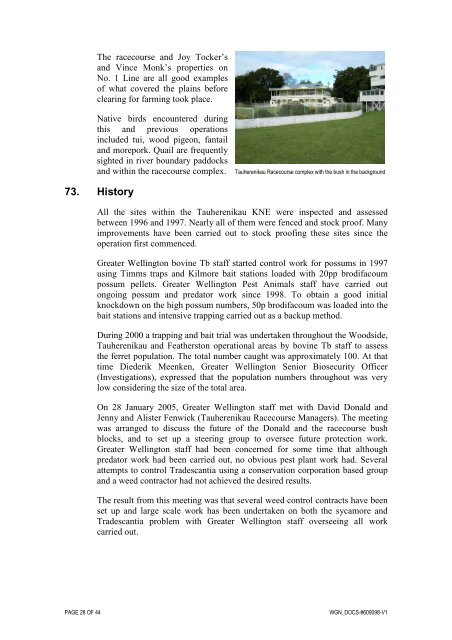Wairarapa Key Native Ecosystem Management Areas - Greater ...
Wairarapa Key Native Ecosystem Management Areas - Greater ...
Wairarapa Key Native Ecosystem Management Areas - Greater ...
Create successful ePaper yourself
Turn your PDF publications into a flip-book with our unique Google optimized e-Paper software.
The racecourse and Joy Tocker’s<br />
and Vince Monk’s properties on<br />
No. 1 Line are all good examples<br />
of what covered the plains before<br />
clearing for farming took place.<br />
<strong>Native</strong> birds encountered during<br />
this and previous operations<br />
included tui, wood pigeon, fantail<br />
and morepork. Quail are frequently<br />
sighted in river boundary paddocks<br />
and within the racecourse complex. Tauherenikau Racecourse complex with the bush in the background<br />
73. History<br />
All the sites within the Tauherenikau KNE were inspected and assessed<br />
between 1996 and 1997. Nearly all of them were fenced and stock proof. Many<br />
improvements have been carried out to stock proofing these sites since the<br />
operation first commenced.<br />
<strong>Greater</strong> Wellington bovine Tb staff started control work for possums in 1997<br />
using Timms traps and Kilmore bait stations loaded with 20pp brodifacoum<br />
possum pellets. <strong>Greater</strong> Wellington Pest Animals staff have carried out<br />
ongoing possum and predator work since 1998. To obtain a good initial<br />
knockdown on the high possum numbers, 50p brodifacoum was loaded into the<br />
bait stations and intensive trapping carried out as a backup method.<br />
During 2000 a trapping and bait trial was undertaken throughout the Woodside,<br />
Tauherenikau and Featherston operational areas by bovine Tb staff to assess<br />
the ferret population. The total number caught was approximately 100. At that<br />
time Diederik Meenken, <strong>Greater</strong> Wellington Senior Biosecurity Officer<br />
(Investigations), expressed that the population numbers throughout was very<br />
low considering the size of the total area.<br />
On 28 January 2005, <strong>Greater</strong> Wellington staff met with David Donald and<br />
Jenny and Alister Fenwick (Tauherenikau Racecourse Managers). The meeting<br />
was arranged to discuss the future of the Donald and the racecourse bush<br />
blocks, and to set up a steering group to oversee future protection work.<br />
<strong>Greater</strong> Wellington staff had been concerned for some time that although<br />
predator work had been carried out, no obvious pest plant work had. Several<br />
attempts to control Tradescantia using a conservation corporation based group<br />
and a weed contractor had not achieved the desired results.<br />
The result from this meeting was that several weed control contracts have been<br />
set up and large scale work has been undertaken on both the sycamore and<br />
Tradescantia problem with <strong>Greater</strong> Wellington staff overseeing all work<br />
carried out.<br />
PAGE 28 OF 44 WGN_DOCS-#609098-V1
















